
39 minute read
BIRDIES FOR GOOD
Birdies for good: Making a positive difference in society through sports
by Nicholas Mundia
Advertisement
We can agree Sports is one of the most powerful tools for social cohesion and economic development globally. The fact that some of the most influential people in the world today are athletes speaks volumes about the pedestal that sport has in society.
So why not use it to make a positive difference, beyond thrilling our hearts and minds from the games that we play or watch? That’s exactly what Absa Bank has done through a novel idea that is making a positive impact in communities around Kenya.
Over the past 13 years, Absa Bank Kenya, in partnership with the Kenya Open Golf Limited, has invested in the Kenya Open tournament helping to transform it from a local golf event to a worldclass tournament, now firmly part of the prestigious DP World Tour.
Popularly known as the Magical Kenya Open (MKO), the event attracts elite pro golfers from across the world. It not only boasts of a global broadcast to roughly 490 million avid golf fans but also doubles up as one of the most anticipated events in the lifestyle calendar.
Amidst the glam and fanfare of the MKO, one pertinent question lingered. What more can Absa do to make a difference, beyond sponsoring the success of the event, bearing in mind the ravaging effect of the Covid 19 June - July 2022 pandemic on Kenyans?
That question birthed the Birdies for Good campaign. A prime idea executed by Absa Bank Kenya, in collaboration with strategic communications firm Apex Porter Novelli, Birdies for Good is all about leveraging the power of Sports to make positive change in different spheres of society.
The goal? Motivate amateur and pro golfers to perform well in the MKO and contribute to a worthy cause by scoring birdies.
Birdie? Allow to me explain. A “birdie” is a golf score of one stroke less than par on a hole. A player makes a birdie when he uses one fewer stroke than the par. (Par is the predetermined number of strokes that a proficient golfer should require to complete a hole, round, or tournament.)
The idea was very well-received by both partners and players. During the 2021 edition of the Magical Kenya Open, the Kenya Savannah Classic, Absa announced they would donate KES 1000 per birdie. The golfers did not disappoint and scored a total of 3824 birdies in both tourneys, raising KES 3.8 million.
Inspired by the motive of the campaign, the European Tour, the global body that oversees the competition matched the donation shilling for shilling, raising the total contribution to KES. 8.8 million.
The campaign was not over though. Prudently and democratically, Absa advertised a request to fund communitybased projects on social media. Once the project proposals came in, Absa colleagues and the public were invited to choose their preferred project via a Twitter poll, an opportunity to neutrally select the worthiest amongst the pool of different life-changing projects that would receive funding.
The winning projects include Lekiji Baraka Women - a project empowering Samburu women entrepreneurs on how to make and sell cultural beads skills, Kina Green Ambassadors - a youth group championing biodiversity and protection of the natural and cultural environment in Isiolo by raising indigenous seedlings and Bright Future Foundation which provides pad banks for girls and The idea keeps gathering steam. During this year’s edition of the Magical Kenya Open, the Birdies For Good campaign raised a local of 1524 birdies culminating in a total of KES 3 million. The funds will be used to purchase, plant, and maintain fruit trees in 60 primary schools across the country. The fruit trees have a triple effect of boosting efforts to boost improve the national tree cover, providing nourishment for the pupils as well as extra income from the surplus of fruits from a harvest.
Birdies For Good, a long-term campaign of so much promise and differentiation, is enough evidence that Sports is a Force For Good and can be used to tackle various social ills that bedevil us.
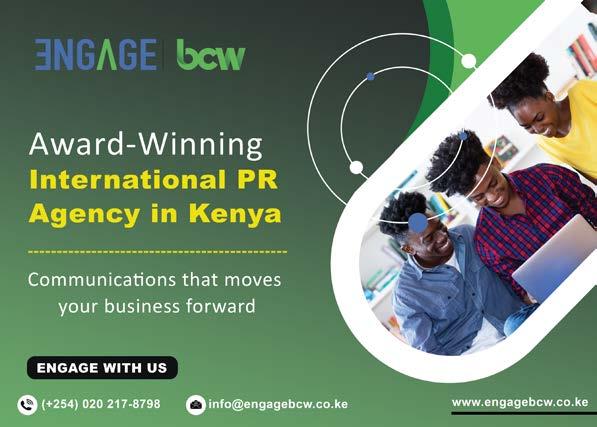


Communicating COVID-19 safety protocols at a time of information fatigue
by Engage BCW
From the first interaction you get with Mastercard Foundation, one thing remains etched in your mind; the five values that drive the Foundation. Humility. Listening. Kindness and respect. Co-creation. Impact. These values embody all engagements and interactions with not only the Foundation, but also their partners from the outreach programs they support. This particular element made our work with Mastercard Foundation under their COVID-19 Public Awareness Campaign not only eye-opening, but also fulfilling, with the knowledge that our communication interventions impacted lives from different parts of the continent.
The Foundation’s main goal in Africa is to enable 30 million young people, particularly young women, across Africa to access dignified work through its Young Africa Works strategy. However, just as with most other organisations where the pandemic led to revision of corporate plans, the Foundation had to re-align to this reality. The COVID-19 Public Awareness Campaign would give the Foundation an opportunity to work with the African youth despite the pandemic challenge. Engage burson cohn & wolfe (Engage BCW) received the opportunity to partner with Mastercard Foundation in the execution of the campaign across seven African countries where the Foundation has established offices, and most importantly, the implementation of the campaign in Kenya. Apart from Kenya, Engage BCW doubled as the Lead Agency for the implementation in Uganda, Rwanda, Ethiopia, Senegal, Ghana and Nigeria.
As people started adapting to living under the ‘new normal’ occasioned by COVID-19, majority of young people started displaying laxity in observing the prevention protocols as laid out by the Ministry of Health. The brief from the client involved developing a campaign that would best reemphasize on the COVID-19 prevention messaging with young people aged between 14 years and 35 years as the primary target audience, without losing them through message fatigue.
In preparing the strategy, we focused on identifying community initiatives, media organisations and digital influencers who would speak to the hearts of our target audience. Considering that at the time, COVID-19 restrictions were still in place, the messaging therefore was geared towards reminding the young people that they would only be able to enjoy some of the freedoms if we all continued observing the prevention protocols to reduce the infection rate. The engagements we proposed had to align with the overall objective of the Foundation to be a catalyst for individuals and institutions, working with others to spur systemic change for the African young people.
This campaign was being implemented at a time many Kenyans were experiencing COVID-19 messaging fatigue. We therefore built our strategy with a major focus on story telling. Showcasing what young people in the country are adopting to the new normal by following the COVID-19 prevention measures and demonstrating the resilience of this demographic would in turn encourage more young people to try out this by themselves. Hence the campaign slogans
#ItsUpToUs – Protect yourself, Protect your family, Protect your community.
To achieve the campaign objectives, we pegged the campaign on three pillars: community engagement, awareness through mainstream media and working with digital influencers.

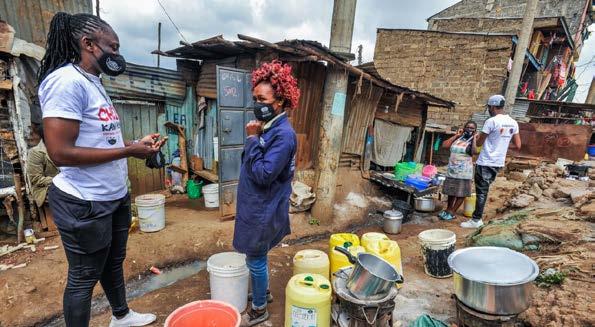
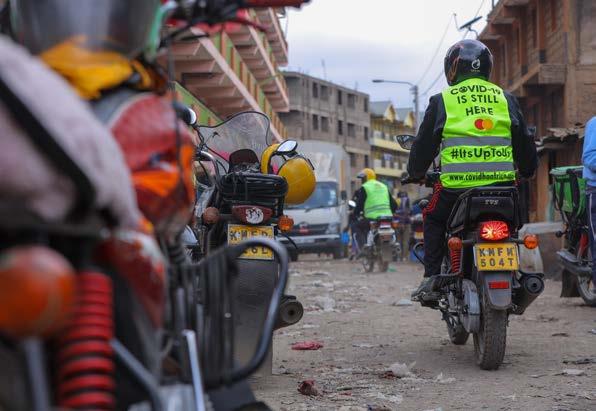

With community engagement, delivery of the campaign’s key messaging would be more impactful by working with opinion leaders within the communities as opposed to having the message come directly from Mastercard Foundation. The Foundation supported community leaders and initiatives to continue interacting with the community residents through the various programmes they pre-dominantly run, but then incorporate the campaign key messaging.
Three community initiatives selected for this were Billian Music Family - based in Mathare, they sensitized the locals on the COVID-19 safety protocols, and distributed free water, facemasks and liquid handwashing soap; ALA Training – Boda Boda initiative – who used a USSD platform under the code *483*955#, to transform boda boda operators from Super Spreaders to Super Savers of Covid-19 through training and awareness creation by offering a COVID-19 curriculum accessed entirely via the USSD platform; and Green Card Mtaani – whose outreach activities centered on improving livelihoods by conducting capacity-building forums for young people and women to help them recover economically by offering training in the production of face masks in Kibera.

Mainstream media assisted in amplifying the campaign messaging by sharing impactful stories from the community initiatives, such as young women who were rendered jobless due to the pandemic and had no way to support their families but now had an opportunity to learn about local production of masks and liquid handwashing soap, as a source of income.
The significance of digital media in communicating to the youth demographic cannot be overstated. We focused on
Facebook, working with Cartoon Comedian (a comedian), Twitter with Minicheps (visual artist) and Kimanzi (social commentator), Tiktok with Barbara Nyambura (comedian) and Instagram with H_art the Band (musicians).
The measure of the campaign’s success for community initiatives covered indicators such as the number of individuals reached through the various engagement methods such as community forums, one-on-one interactions and special group visits e.g., churches etc. For instance, Billian Music Family reached out to 380,000 residents through distribution of 10,000 masks, 4,000 litres of handwashing soap, 200,000 litres of clean water, coupled by visits to schools, churches, places of business and the use of boda bodas to crisscross the Mathare villages with public service announcements via a public address system.
The resilience and impact stories from these projects were aired on 35 media organisations including Switch TV, TV47, KTN, Citizen TV, Capital FM, Ghetto Radio, Inooro TV, Kameme FM, Nam Lolwe and CGTN. On the digital space, impressions from the messaging by the five influencers managed to reach 2.1 million accounts over a two-month period.
All in all, this campaign enabled us to demonstrate co-creation between the client and agency in delivering not only communication goals, but also ensuring that the project monitoring and evaluation is aligned with the overall communication goals in running an effective behavioral change campaign.
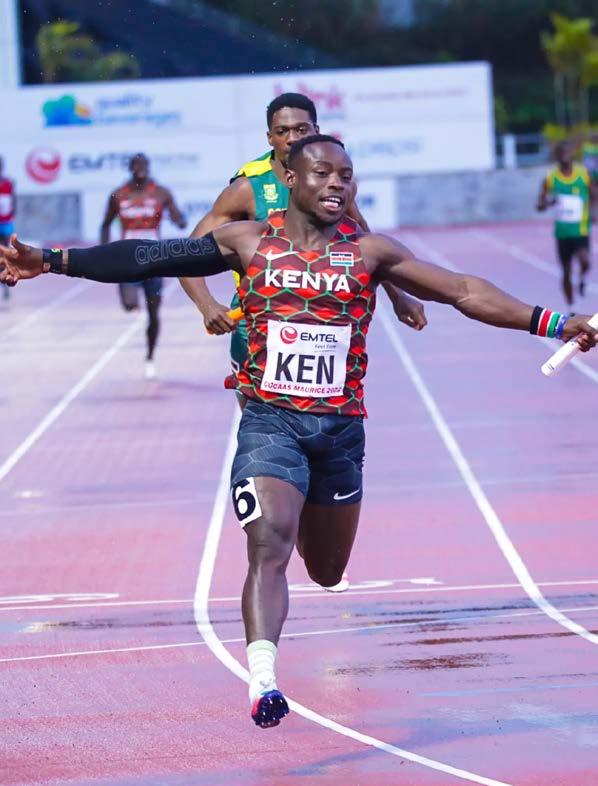

Omanyala: My Father is my hero but I still prefer getting home at night
By PRSK special writer
He is also one of my advisors, a very good man and my hero who has been hit by many things in life but he still stood by us at home, always said not everybody is good, so I must be more careful
When Ferdinand Omanyala tried competitive event which was organised by Athletics Kenya (AK) in Mumias, Kakamega he was almost denied a chance to run because no one knew or had heard of him. He was assigned the outer lane as an afterthought. He won, but still left no impression. At the following event in Busia, he outclassed the field, beating the runner-up by a yawning gap! He still looked like a flash in the pan, AK simply ignored him. It is against this backdrop that he says, he had to run fast and prove himself, for in life, you cannot get what you want immediately: you have to go through challenges. Challenges make you stronger, he believes. Now he is a celebrity and has to deal with a demanding public fully aware that the glory that comes with his success has tossed many promising athletes off the course. The most memorable case in Kenya’s long-distance running was Samuel Wanjiru, who at nearly Omanyala’s age, could not handle stardom and it cost him his life.
The third born in a family of four siblings, in Bungoma, where he was born, had a childhood like that of any other rural child- taking his studies seriously and doing his best to turn the family fortunes. However, today, things are different for Kenya is now in the grip of Omanyala-mania – after the young sprinter emerged from shadows of American and Jamaican short-distance runners to take the athletics world by storm.
Omanyala, whose name means ‘you can’ in Bukusu, has metaphorically ‘split’ from the legions of long distance-running that is synonymous with Kenya, shining at the tail end of what was an occasional blip in the field events where Julius Yego shone for a while before receding with sterling feats in the Olympics, world championships and Diamond League circuits.

I ran to get a car then retire
Omanyala, a Bachelor of Science (Chemistry) student at the University of Nairobi suits the description of a late-bloomer in athletics – having realised his potential when he detoured from his first love in sports – rugby – to try his luck in athletics. In his own words, his plan was to run “for six months, make money, buy a car” then return to rugby. In rugby, he brushed shoulders with some of the finest players in the world sevens circuit like Collins Injera and Humphrey Kayange, whose intimidating presence spurred him to want more. The lavish life-style of the elite rugby players intrigued and inspired him at the same time,
Omanyala, whose name means ‘you can’
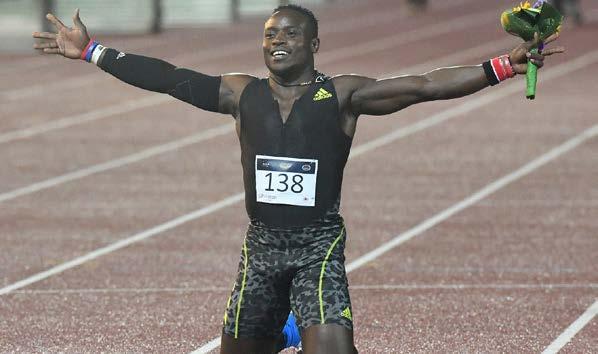
spurring him to match them. He took up athletics when he was already past his teen-years, having dazzled in rugby, a popular sport in western Kenya.
A Friends School Kamusinga alumnus says that, while he knew he was a good athlete, he did not expect his meteoric rise to stardom to come soon. The transition from rugby to athletics stardom, Omanyala admits, was unforeseen and, the ‘longevity’ was even more difficult for a young athlete who only wanted to make some quick buck, buy a sleek car then return to the team sport he was used to since boyhood, then complete his bachelor’s degree which has taken a ‘commercial break’ as the world’s new track sensation tangos with the high and mighty in the sport, who he now wants to overtake to the summit of athletics. “When you do something, you always think big and you always have goals. I had a dream that I would one day be a star, but not this big. My imagination was not how this is happening. But you know God gives you things in doubles; double blessings,” the easy-going sprinter recounts. His secret? Selfbelief, resilience and optimism. He leaves no doubt that he is a gifted sportsman and university student who is fast-evolving into an athletics icon adored by the young and old, and the wealthy and powerful around the world. However, growing up and going to school in a rural setting may have delayed development, never killed his dream.
Plyometric training
“Sprint takes so much from you so you have to be good. I train for 9 hours a day when we are in season. There is gym training, there is plyometric training which typically improves speed and agility, there is track training. There is so much for you do to be an athlete,” he says. He did not have the kind of facilities he now has access to in Nairobi and during his travels to Europe on the international athletics circuit.
During the ‘off-season’ – the time international calendar takes a break – Omanyala’s schedule is spartan in character. He trains nine hours a day and this is besides attending classes and monitoring his business. However, he is coy on details of the business, which he refers to only as a “side-hustle.” His in-season punishing training schedule relaxes a bit but he still has to endure long hours hopping from one end of the globe to the other to take part in the Diamond League, national championships, IAAF, continental championships. He is now preparing for World Championships which will take place in Oregon in the USA in July, which will be followed by Commonwealth Games in Birmingham, England.
“My first time in Nairobi was in January 2015. I was with someone who was guiding me, so it was not as bad as people always say about their first experiences. (This was before) my first time to fly, when we were going to Bahamas. I remember I wore a suit for the first time all the way to Bahamas and I found it funny,” he quips. “It was interesting at the same time because that was also my first time to fly,” he adds as he recounts how his globe-trotting began. I remember I wore a suit for the first time all the way to Bahamas and I found it funny,” he quips. “It was interesting at the same time because that was also my first time to fly,” he adds as he recounts how his globe-trotting began.

Despite his broadened world-view, Ferdinand still looks up to his father Fred Omurwa, whom the 26-year-old Omanyala describes as his hero and man of a ‘steel heart’ who has stood steadfastly with his family at all times. “He is also one of my advisors. He is a very good guy and my hero who has been hit by many things in life but he still stood by us,” he says. Omanyala does not hide his desire to break the 100m world record.
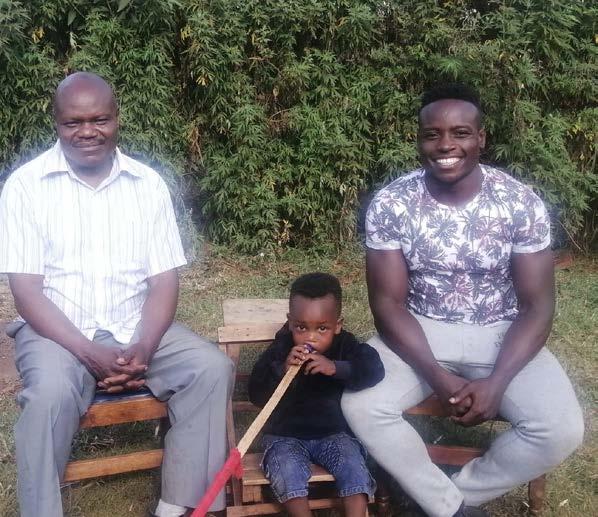
Never be intimidated, I will break Bolt’s record
“I have already beaten them. I beat the American Olympic silver medallist (Gatlin) here in Nairobi. It is unfortunate the Olympic gold medallist did not take part in the event. He was my target. He is the one I want to beat when we meet in Oregon,” the sportsman says. He believes that they are human just like us and that nobody goes to the petrol station to be filled up with petrol. It all starts with the mind. “We have been intimidated before. You get there and you meet the guys you have been seeing on television. Imagine competing against a legend like Usain Bolt. You can be a very fast guy but when you get intimidated on the track, it hinders your performance. That is something we need to change, “he asserts. He vividly recounts how Akani Simbine (former African champion from South Africa) approached him before a race and told him not to run ‘too fast’. One of his coaches told him “Don’t finish our guy, the world is watching and they now know what they are coming up against.”
I will make Kenyans forget politics for a while
He is good friends and keeps contact with some of the fastest sprinters like Blake and Gatlin who he says, are ‘so respectful right now’. He believes he is going to be the athlete who will break Usain Bolt’s world record. “The promise I make to Kenyans this year is to break records and win championships to make Kenyans forget about politics for a while,” he confidently says. Heading to the world athletics championships in Oregon, USA, in July the sprint sensation holds the world leading time of 9.85 seconds – and is determined to beat Americans in their own backyard. After setting a new African 100m record of 9.76 seconds, he says he has set his eyes on equalling the world record currently held by Usain Bolt of 9.58 seconds. He wants to lower it to 9.4 seconds.
The all-time 100m is as follows: 1. Usain Bolt (9.58), 2. Tyson Gay (9.69), 3. Yohan Blake (9.69), 4. Asafa Powell (9.72), 5. Justin Gatlin (9.74), 6. Trayvon Bromell (9.76), 7. Christian Coleman (9.76) and 8. Ferdinand Omanyala (9.77). Omanyala-mania is not restricted to athletics in Kenya, it is spreading to the rest of the rest of the world, where Kenya’s dominance in the middle and long distances is legendary. What makes news – perhaps – is the occasional failure to win both men’s and women’s 800m, 1,500m, 3,000m dash, 3,000m steeplechase, 10,000m and the marathon. But a Kenyan reigning in the sprints in Africa, leave alone obliterating the big guns from America, Europe and Jamaica is

Pursuing wife for 6 months
The father of one who loves Afrobeats and chicken and who has publicly admitted to getting financial support from his wife when they were starting out before his fortunes changed, did not have it easy. He pursued her for six months in 2016, before she finally gave into his advances and they finally tied the knot. Omanyala says he has to work harder to continue providing the best life for his son and wife despite many beauties who try to pursue him. “When I am not training, I am mostly in the house or attending to personal meetings that require my personal attention,” he says. home since latest win.
When he visits his rural home, he rolls up his windows up because he believes not everyone I of good intent. He actually prefers to get home at night. He is yet to go home since his latest win.


“When I switched from rugby to athletics, I expected to run faster because I was so fast in the field. My plan was I get into athletics for like six months, get the money and go back to rugby. It is now six years and I am still here, “he says laughing. His love for fast cars drove him to athletics as he was confident he would get one in just six months and go back to Rugby. “I used to be intrigued by the likes of Collins Injera because they would pull up at the training ground in their vehicles. I wanted to live that life. So, my plan was to get into athletics, get the money and go back. I have fallen in love with sprints and I am taking it higher and higher,” he said during an interview with Citizen TV.
Aware of the risks that are laden in stardom, he says, “I thank God for giving me strong mental strength. I hear a lot but stardom has not changed me. Even the President of World Athletics (Sebastian Coe) who was in Mauritius (for 2022 Africa Championships) was wondering, ‘How are you guys winning sprints?’. ‘We are coming for you guys. I am coming to beat the Americans on their own homeground’ was his response. He goes on, “There were times we used to see people run fast barefooted in the rural areas … if only we can get good facilities, these children can go far! The problem is, we have not had a good sprinter before in Kenya. When your see your child, niece of nephew trying do sprints the perception is you can’t go anywhere with this. Now the perception is changing. I am glad I am one who is changing that. I hope in the next 10 years – like you saw in the 4x100m relays – there other athletes coming up.”
Association with PRSK
For someone who has never had any formal training on how to communicate or address the media, he believes that there is massive opportunity for communicators out there to help change the narrative on the eloquence which uncharacteristically identifies Kenyan athletes. “One day, I was browsing on my phone then a post by PRSK popped up on my phone. I had never heard of it before and it piqued my interest. Since then, I have seen articles and other posts on its Facebook page,” he says. His trick is to wait for the question then answer the best way he can.

Sprint academy
“This the thing these guys are calling Omanyala-mania is the rowing interest is sprint. I ask the government to support it. I am coming up with a sprint academy to develop sprinters so that when I will be out of the sprints at some point (there will be somebody to succeed me). I don’t want to leave a vacuum in sprints in Kenya. I want this to continue after I retire from the track. There should a sprinter being discovered in Kenya every year. If we get the sponsorship, if we get the right support, it is going to be a big thing,” he says.
by Elizabeth Mulae
When people lose a loved one, choosing the right words to condole, sympathise and empathise with the grieving family is not an easy task. The wordings, language selection, tone and how the sad news is relayed may result in positive or negative connotations.
This also applies to social media groups created to facilitate burial planning period, obituaries published in print, radio and aired on television stations. Recently, a death announcement run by one of the dailies attracted mixed reactions with social media platforms generating heated debates on suitability of the wordings used. The criticisms, varied comments and deliberations were based on the packaging of the content by the family with some commentators blaming editors for allowing the obituary’s publication.
( An obituary of in one of the newspaper dailies recently caused an online stir with Kenyans questioning whether it was intended to be humorous or an insensitive joke.
Part of the funeral announcement read, “Mueni has now reunited with her beloved father Anthony and her partner in crime Peter and they can get up to their typical mischief where they left off.”)
All calmed down when information came through the same daily that the family had approved it as it were to reflect the lifestyle of their relative who had died.
Grief communication is a subject that requires preparation emotionally, physically and spiritually, whether it’s done socially or in corporate entities. The communicator should respect the feelings of the bereaved person showing empathy on the intensity of the loss of a loved one. An observation of how different corporate entities communicate during the demise of a staff member indicate different approaches used to communicate the sad news; Common ones include sending a message on the corporate whatsapp groups and emails. The message is revered by many wishes of condolences, say, ‘ very sorry for our loss, May their souls rest in peace, the spiritual ones will share a bible verse or so for encouragement.’ Some follow up the message with a call to the bereaved as a show of empathy. Different organisations have adopted various approaches to communicate to the bereaved families, with hope of encouraging them to bear the loss.
Some churches have also formed support groups that promote grief communication. One of them is Grieve Share which is a group that gives people an opportunity to share and communicate more about grief. Ms. Claire Gicheru, a communication expert, has been involved in Grieve Share for several years. She says that it was created to walk grieving individuals and families through the journey of overcoming grief through sharing. The group, currently hosted by the Parklands Baptist Church, has run from season one to eight. The organisers are currently planning to begin season nine. Grief Share is a grief recovery support group where you can find help and healing for the hurt of losing a loved one.


As we all know, losing loved ones is a life transition that none of us can run away from. Learning how to communicate about grief is a good step for all to embrace. A few suggestions on where to begin when someone is grieved include;
1. Call Them
With the digital world becoming dynamic by day, most people are losing the art of conversation, which has numerous benefits and advantages, during loss of a loved one, you find people sharing messages with the bereaved in different platforms available, whilst this is okay, calling someone to comfort them makes a big difference, hearing comforting words from someone else provides relief and emotional support.
2. Share A Message of Encouragement
The period of grief makes people withdraw as they come to terms with loss of their loved one, share encouraging messages to help them towards accepting the loss, bible verses on life transition come in handy.
3. Choose Words Carefully
Words can make or break a soul, choose carefully what you share or write to the bereaved, this is a sensitive period for them and they never forget what you said to them.
4. Listen more
Sharing the details of the loss is part of the healing process, allow the person to share what they feel comfortable to release; give
5. Plan a visit to share condolences by presence
Attending the burial planning meetings shows concern and empathy for the bereaved. If you don’t make it for the meetings and funeral, commit a day to visit the family and relay your condolences. Grief is a process and does not end after the burial. Visiting the concerned family comforts and strengthens the family to accept the loss and get through the process courageously.
Death is a transition to another life and world which all must take at unknown day and time; as we live our lives, let’s adopt an empathetic approach that comforts the bereaved in our circles.
Public Sector Campaign won by Vivo Energy & National Transport and Safety Authority

Vivo energy in collaboration with the National Transport and Safety Authority bagged the Public Sector Campaign of the year award in honor of their joint road safety campaign dubbed “Tuvuke Salama Barabarani”. A phrase that has so far been owned by most organizations and individuals for its effectiveness and the impact it has its target audience. A team from PRSK met the duo and this is what they had to say as they shared their journey through the campaign, the inspiration behind it, the impact it has had since its launch, challenges encountered what made them stand out and what other plans they have.
The Voice of the voiceless
This initiative was driven from a point of concern to the school going minors in order to reduce mortality cases caused by road accidents. At least 4,000 fatalities were reported in the country in 2021 according to a report on the NTSA database, a number that is expected to rise if nothing is done, a move that had the team from Vivo and NTSA come up with the campaign.
It’s not always about branding
These two organizations coming together was a blessing in disguise. It was necessary for them to connect with the community and address their pain points. The duo challenged other organizations to identify gaps within their communities and address them without looking at the profit value.
Not even COVID could stop them
Everything happened so fast and one of the big challenges they faced during this campaign is the rise of corona virus disease. “We just launched our campaign in Mombasa and had plans for the Nakuru launch when the Cabinet Secretary for health announced a country wide lockdown”, recalled Vivian. The countrywide lock down was followed by abolishing of public gatherings, which made it hard for them to roll out their educative fora on road safety measures. They had to quickly leverage on social media and make their campaign largely online and thanks to their massive following, this was received quite well.
Lollipop Signs!
The Lollipop Signs are the tangible product of the campaign. These are hand held road signs issued to crossing guards at the very busy roads that near schools. These signs alert road users to slow down when children are crossing the roads. So far one hundred pieces have been issued countrywide on the first round with four hundred more awaiting distribution upon identification of the most dangerous spots, a report that will be compiled by a team from NTSA. The aim is to ensure all highways nearing schools get a sign in a move to ensure zero accidents

Consultancy skills for PR Practitioners are fundamental
by Sam Karanja, Executive Director – Hill & Knowlton Strategies
It is said that change is inevitable. It is actually considered as part of life. In the world of Communications and Public Relations, change is manifested in various perspectives. We now see more PR practitioners than journalists. There are increased multimedia content and platforms than ever before. Moving from a traditional and rigid structure where there was a defined scope and set routine with a rigid and mechanical flow of activities.
Communication Consultancy
Communication Consultancy involves providing advice and suggesting strategic communications and marketing solutions tailored to customers’ requirements and needs. It also involves assisting in the packaging of both internal and external communications. A strategic communications consultant gives recommendations and guides the entity on how to effectively implement communications strategies. As a communication consultant, it would be important to develop your breadth of expertise to win the convergence war and extend your depth of knowledge to position yourself as trusted advisor with your client/organisation. Take into account the key features of a classic communications consultant which include being responsive and creative. The breadth of knowledge and skills comprise various strategic areas such as stakeholder engagement, behavioural science, digital planning and optimisation, public affairs and litigation communication.
Another focal component for communication consultancy is data analytics for computational analysis and use of statistics to represent information. The approach involves applying data patterns geared towards attainment of effective decisionmaking processes in organisations. Other crucial areas include crisis communication and creative studio skills. The bottom-line is that there is a need for enhanced training and capacity building programmes in relation to communication related topics.
Communication strategies informed by behavioural science
This involves a process of applying the science of human behaviour to the art of communications. The latest insights from behavioural science help us understand how people actually think and act in real life – and how we can influence this. People often behave in ways that are surprising and seem irrational:
- consumers do not always switch to better or cheaper products - our colleagues do not always switch to more effective working practices - most of us do not save, exercise or eat as healthily as we know we should
Behavioural insights reveal that most human behaviour is driven by automatic, instinctive and intuitive thought processes. Even decisions we believe people make rationally are often automatic, influenced more by context than by consciously thinking something through. A consequence is that communications strategies based on appeals to people’s rational thought processes are insufficient. Take for instance tax compliance. Evidence has demonstrated that communication strategies based on stressing the legal consequences of not paying tax is not effective.
It is important to consider enhancing skills in emerging areas such as coding and web development, digital and social media laws and ethics, data driven digital PR and insights optimisation, paid social media management among other emerging issues and trends. The Communications and PR industry has certainly evolved and it is necessary for practitioners in this profession to equally sharpen their skills. It is imperative for them to be aware of the ever-changing trends in PR and through this, it will be possible to provide skilful consultancy services that resonate with the expectation of the client organisations.
Diversifying public relations in universities
by Sharon-Hope Abiyah
Public Relations as a profession is experiencing tremendous growth globally and regionally. The need for the profession in organizations has become critical. The dynamism of emerging communication gaps in organizations necessitates the need for strategic Public Relations practitioner’s skills to address such kind of needs. Public Relations in definition clearly states its core mandate of being a management function whose goal is to build strong stakeholder relationships geared towards establishing mutually beneficial relationships between an organization and its public. In a highly competitive business environment, it is Public Relations that set the base and momentum for marketing to thrive. Ignore Public Relations at one’s own peril. Institutions of higher learning are not exempted in this discourse. Today, universities are working round the clock to develop messages and communicate in such a manner that connects with the market. Lack of strategic and clear communication is prerogative to failure.
The emergence of competition and struggle for numbers amongst universities birthed the need to adopt creative and innovative ways of communication to tap into the shrinking market. These saw universities place advertisement in print and mass media hoping to influence attitudes, behavior and decision making. A blended approach in developing communication strategy is also growing each single day and its impact cannot be ignored. It is common to find universities on Tik-Tok, You tube, Instagram apart from other conventional digital platforms.
As a public relations practitioner at St. Paul’s University attest; institutions are working round the clock daily to study the market and come up with cutting edge public relations strategies and mechanisms that are able to penetrate the market and ignite interest towards the university among the public. In his words, “One of the key platforms we are utilizing fully is the social media. This is where our market is and we must ensure we align our strategies to tap into this space”, he said. The digital platform has become a useful segment of the market that the university is committed to tap. This is where majority of the teens and youth congregate to socialize and find information. Therefore it is crucial market no institution can ignore.
Another key feature in public relations emerging trends is mentorship and training of future public relations practitioners. Without doubt, the classroom experience is fantastic, but if not aligned with practice, it ends up not achieving its intended purpose. The university is keen to ensure public relations grow beyond theory. The practical component of the profession is what makes it stand out. The world is looking for highly practical public relations talent. The market does not have the luxury of time for practitioners who have not mastered their craft. The competition is real; a proof that only the best will have their say. At St. Paul’s University, the need to nurture and train competent public relations practitioners is a matter taken with a lot of seriousness. The concept of mentorship has been inculcated across departments and offices. Students are attached to departments strategic to the program to learn and utilize skills from a practical point of view. The Public Relations and Marketing department has multiple platforms for learning and growth. Through the Public Relations and Marketing Club, students are acquainted with event organizing skills; a critical component of the profession. Through annual and quarterly publications such as “The Voice Magazine” and SPU Connect Magazine”, students are able to learn and apply key interviewing, writing and editing skills. Notably, public relations in its dynamic nature are growing to greater dimensions. The public sector, corporate organizations and humanitarian bodies have also embraced the role the profession plays in harnessing clear and effective communication to its public. This is an indication that public relations play an important role and its impact is being felt across all sectors, universities included.
communication Summarised By Elizabeth Mulae
The last year’s PRSK summit enlightened many of the PR practioners in regards to milestones achieved in the communication sector in the last 50 years , This made possible through the various presentation shared by experts attending the sessions, among them was this presentation by Atieno Atieno summarised in this article
Some of the key Principles guiding Government Information include:-
i. The public has a right to information and communication; actively sharing information is therefore one of Government’s most important task ii. The public is entitled to communicate with Government
iii. Communicate information of policies, projects and programme
Notable events on Government Communication Growth
In the last 50 years, Government communication has transition through various events and periods such as the scramble and partition of Africa, The role of the state broadcaster as the Governments Mouth piece, Liberation of the airwaves which formed a new democratic system and the new communication formula.
Other events include the Promulgation of the new constitution, County Government Act part 9 on public communication and access to information in all the 47 counties and digital progression growth.
The counties have also created public information and communication offices who are charged with creating public awareness on the mandate of the counties using assets like the websites, social media pages, telephone switchboards, USSD codes and customer care reception desks.
The Government communication growth has faced various challenges such as recognition of communications as a valuable strategic tool, declining public interest and diminishing communication standards.
The rapidly changing media landscape has also come with its share of challenges among them emerging issues on citizenry reporting and social media. Allocation of budgets for communication activities have also continued to shrink causing low to zero implementation of planned activities.
Enhancing government communication
Improvement of Government communication can be done through the Development of robust policies and strategic plans, equipping newsrooms with modern equipment to promote effective dissemination of information, recruitment of qualified personnel and continuous capacity building. In promoting a listening organizational culture, the government can activate feedback mechanism channels to enhance two way communication with the publics. To continuously safeguard achievements gained in the last 50 years towards enhancing communication in Government, more focus on developing the sector is required. Adequate resource allocation will ensure implementation of plans and strategies which will be made possible through recruitment of a competent team to support the processes.
The winning game will be packaging of Government content in a persuasive, strong, concise and clear manner.
This way, the information will remain as the ‘ King’ and ‘queen’!

Enhancing reputation management in the next 50 years: Role of PR

By Judith Sidi Odhiambo, KCB Bank Head of Corporate Affairs
Public Relations is a careful art that is concerned with a myriad of activities revolving around reputation. Public Relations is the discipline which is focused on reputation, with the aim of earning understanding, trust and support and influencing opinion and behaviour. It is a planned and sustained effort to establish and maintain goodwill and mutual understanding between an organisation and its publics.
The Opportunity
It is understandable that PR remains a critical area for businesses that want to succeed. PR is seen as a cross-cutting management function since time in immemorial and it will continue to remain so. The need for incorporating PR into a business will not go away, as it is an important pillar for profitable operations. PR is concerned with value addition, elevated brand awareness as well as maintaining a positive image. Today, more people understand the importance of PR and appreciate its value. In this digitally driven world, we are at a transition phase into modern PR. With modern PR, our touchpoints are shifting from what they used to be years ago. We certainly cannot wish away the evolution process brought about by this transition. How we relate to our publics & stakeholders is evolving from e.g. developing press articles and being satisfied to utilizing social media as well.
Power of Social Media
Social media has increasingly become a barometer of stakeholder perceptions. Social media provides a direct connection with your audience. is a very important medium, measure and mirror of public officers and general stakeholders’ sentiments on various issues. It is therefore a very important tool and medium in the practice of public relations since it focuses on building and maintaining relationships and is not just about brands connecting with their stakeholders. Social media impacts relationship building in positive and negative ways.
Typically, social media has a mix of the informed, the uniformed and the cheerleaders who follow both ends of the spectrum. Social media therefore is not always a very credible tool. Informed positions sometimes can suffer from the wider commentary advanced by the uninformed who particularly hide under the veil of identity hidden accounts. Many a times, festering issues on social media if unattended tend to grow to real crisis matters.
Social media can similarly be used to build trust with key stakeholders and publics largely through the provision of information and issues management. However, where social media is actively utilized as a barometer on trust, interventions can be deployed to mitigate greater risks.
Generalization of messages is part of traditional PR, not modern PR. The future entails more personalized engagements to achieve a communication goal. Personalised interactions breed more trust and confidence. An example is as opposed to sending a statement to launch a product, modern PR entails teams visiting publics in their spaces to explain the launch and make the specific audience why they need to care.
Public Affairs
Public Affairs is a strategic effort geared at first analysing public stakeholder needs and moving to design and provide solutions that facilitate effective engagements. It involves the day to day management of the relations with stakeholders using a range of Typically, it involves the unpacking of the organisational needs to enhance understanding by the stakeholders. Public affairs also involves guiding stakeholders such as Legislators to formulate favourable policies that support the organisational missions including favourable taxes, regulations and even incentives. Public Affairs largely focuses on public interest. It is way beyond just the institutional commercial interests and focuses on policy and regulatory aspect. Ideally public affairs acts as the cementing agent between an organisation and its public stakeholders who are majorly in government decisionmaking processes or who influence position. Sustainability has shifted from being a buzzword on environmental matters to a keyword in corporate matters. More corporates will be paying attention on key matters which include; inclusivity, climate related concerns, society needs and so on. The world is rapidly deteriorating, and it is up to us to preserve it for generations to come. In conclusion, it is important to remember that PR undoubtedly remains to be a cross-functional touch point in the business environment. Audiences are more likely to trust messages that are packaged in a manner that builds trust and credibility. As the industry evolves, so should our mind-sets if we are to effectively achieve our objectives.


